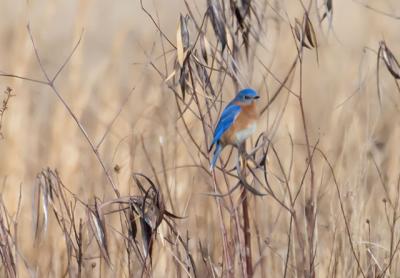Nature Notes: Chorus of the Season

March came in like a lion and a lioness. Now it’s time to get on with spring. Notwithstanding two major coastal storms, signs of spring have been filtering through the stormy air. On Monday, Victoria Bustamante of Montauk spotted an osprey perched on a cellphone tower on the south side of the Sunrise Highway in Hampton Bays. My wife, Julie, checked the five osprey nests along Long Beach and Sag Harbor Cove the same afternoon, but there were no ospreys to be seen.
However, she reported that the beach drive was strewn with drying vegetation and sand from the recent tidal over-washes. She also observed that the many gulls that characteristically populate Long Beach each day were lined up like sentinels, eyes focused on the bay in a long row from west to east on the rises created by the stormy tides.
There have been several reports of spring peepers from different parts of the South Fork. T.J. Devries, who listens for the first ones every spring, heard a few peeps coming from the wetland at the end of Mile Hill Road in East Hampton on Feb. 27, several days earlier than his previous record, which was March 2. Members of the Third House Nature Center heard some peepers peeping here and there on their Saturday outing around Big Reed Pond and other parts west of Montauk Point.
By this time next week, the peeper chorus should be in fine fettle.
You may have noticed that red maples are already budding and that a few familiar shrubs, forsythia in particular, are also in the throes of budding out. Drive along Swamp Road and other local back roads in East Hampton and Southampton and you can’t help but notice the burgeoning trees and shrubs.
Such is a very pleasing sight each spring and particularly this spring in Northwest Woods, where it takes the mind off of the hundreds of downed pines, felled to control the dreaded southern pine beetle’s invasion. One wonders if such a crippling attack by this little insect has ever been experienced here or on the rest of Long Island in the past? I would think not.
The pine borer has been killing trees west of the Shinnecock Canal for five years now. It may be just one of the many impacts of global warming we are now witnessing here and in New England.
The third great faunal event that announces the beginning of spring here, along with the return of the ospreys and the emergence of spring peepers, has yet to begin. However, the alewives are already massing in our bays and harbors and it won’t be long before they begin entering the streams and creeks in search of quiet fresh waters for spawning. The largest continuous run of this herring on Long Island is the one that has occurred every year well back into history with nary a miss from North Sea Harbor to Big Fresh Pond in Southampton Town. Unless you are standing at the edge of the little bridge where Alewife Brook runs under Noyac Road at its western terminus at 2 a.m., you are likely to miss it. But you get an idea that it is happening when you see night herons camping on the trees and ospreys making numerous passes at that spot come the second or third week of March.
Another obvious sign of the coming spring is the appearance of blackbirds and robins along the roadsides and in the fields. In these last two decades they have been joined by another thrush species, the eastern bluebird, New York’s state bird. They have been making a comeback here since 1987 when Kari Lyn Jones of East Hampton Village and her helpers started erecting bird boxes made by the late Kim Hicks of Montauk following the observance of a few bluebirds in Hither Woods in the early 1980s. Since then, under Kari Lyn’s and then Joe Giunta’s annual efforts, the local bluebird population has flourished.
The long annual march of birds from the south to the north is underway. The ospreys are returning, the spring peepers are entering freshwater ponds to spawn, and the alewives will soon join them for the same purpose.
I am reminded by a column by Marilee Foster in The Southampton Press of the relationship between the heralds of spring and the annual rite of plowing and planting. Lest you forget, there was a time in the not-too-distant past when fishermen and farmers made up the majority of the East End population. While only a few of these observed nature to the point of becoming natural historians of note, such as the potato farmer Roy Latham of Orient and the duck farmer Roy Wilcox of Westhampton, each and every successful farmer and fisherman was a student of things happening in the great outdoors, the annual changes in weather, the changes in flora and fauna, changes in the elevation of ponds and creeks.
So, in an age when real estate agents now outnumber farmers and fishermen on the South Fork, Ms. Foster, daughter of the late, great Sagaponack farmer Cliff Foster and his wife, Lee, equally adept at growing and harvesting things, wrote in her weekly column in last week’s Press, “Just after dark, she came through the back door, into the kitchen, dropped her bags and, in an exaggerated fashion, with both alarm and delight in her voice, announced: I hear peepers!”
You can be pretty sure that when peepers are heard for the first time each spring, a farmer or fisherman was probably the one who heard them.
Larry Penny can be reached via email at [email protected].
